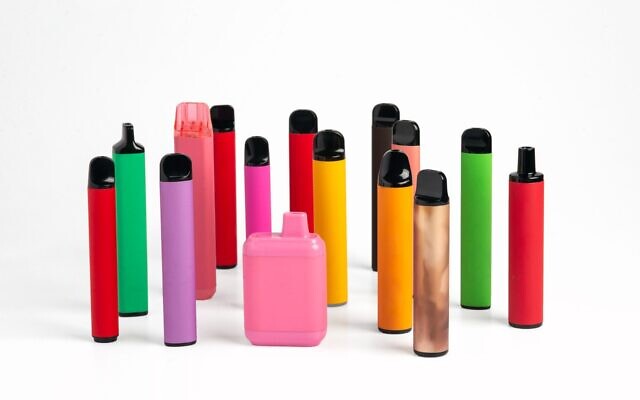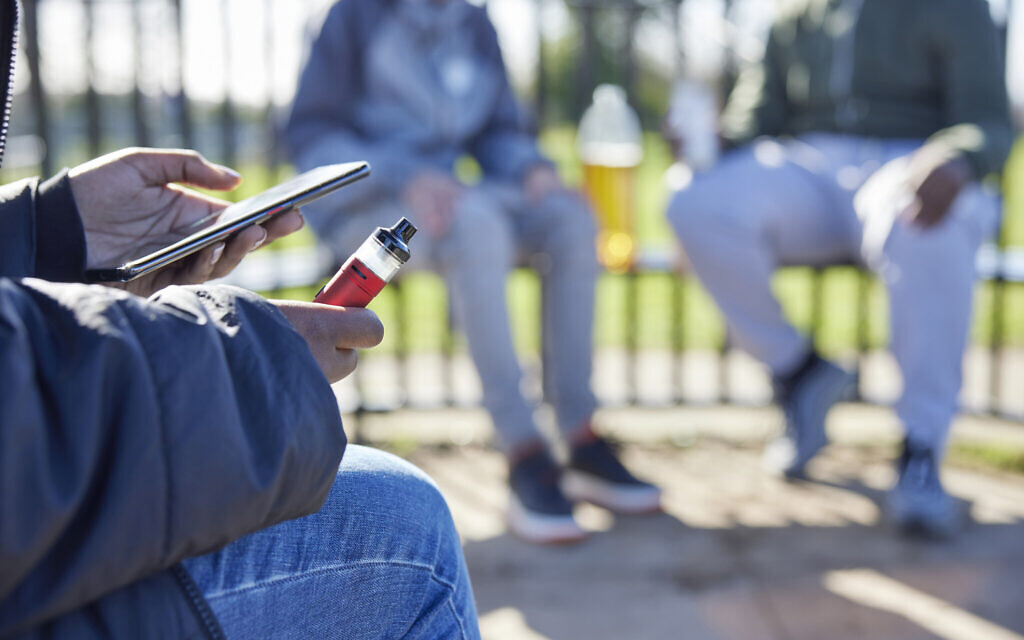With tobacco use on rise in Israel, kids and teens see their health go up in smoke
Bright colors, fruity flavors, and nicotine are getting kids as young as 12 hooked on vaping, while adults’ outdoor secondhand smoke is embedding itself deep in children’s bodies
In recent months, two Israeli teenage boys were hospitalized with collapsed lungs caused by vaping, or smoking electronic cigarettes. One recovered, but 16-year-old Meidan Keller died after becoming disconnected from an extracorporeal membrane oxygenation (ECMO) machine, which provides cardiac and respiratory assistance. The disconnection is under investigation by the Health Ministry.
“Unfortunately, electronic cigarettes are accessible to [children],” Keller’s grieving father Yariv said. “As parents, we were involved in Meidan’s life, but there is no [total] control. You can educate, but it’s hard to prevent cigarettes.”
As a result, government health authorities and anti-smoking organizations have ramped up their efforts to warn children, teens, and their parents of the dangers of highly addictive vaping, which has grown in popularity in Israel in the last five years. Anti-vaping public service announcements aimed at teenagers are being broadcast on television and circulated on social media.
But will teens and young adults be convinced of the dangers of vaping when countries like the UK encourage it as a safer alternative to combustible cigarette smoking and a means toward quitting smoking? Will they be swayed by the news this past April that Juul Labs paid $462 million to settle lawsuits brought against it in several US states claiming that it aggressively marketed its vaping products to young people, thus accelerating a vaping crisis?
What are the chances of youth heeding the warning at a time when Israeli smoking rates are rising again after decades of decline, and many adults are not protecting children against the adverse effects of secondhand smoke and cigarette-related toxins?
Smoking is on the rise again in Israel
“Eight thousand people die from tobacco use every year in Israel. Eight hundred of them from passive smoke,” said public health professor Laura Rosen of Tel Aviv University, who has studied the effects of tobacco smoke on children for the last 15 years.

According to a report by the Taub Center for Social Policy, as of 2020, the smoking rate among the Israeli adult population 21 years of age and older is 20 percent, higher than the OECD average. A quarter of men and 15% of women smoke, with rates higher among Arabs than Jews. The COVID pandemic made it worse, with one-quarter of smokers adding 13 more cigarettes to their daily routine.
According to the report, “one-quarter of all youths smoked an electronic cigarette, possibly under the false belief that it was less risky than a traditional cigarette.”
A report on smoking issued by the Health Ministry in 2021 stated that after a significant drop- off in youth smoking between 1998 and 2019, the trend is reversing. Now 20% of youth (more boys than girls) smoke, with half of them smoking tobacco and half using e-cigarettes. Whereas in the past teens were initially introduced to smoking through cigarettes and hookahs, by 2019, they were reporting more use of vapes, some as early as age 12.

Israel Cancer Association (ICA) health promotion specialist Dana Frost told The Times of Israel that kids have become hooked on electronic cigarettes — especially disposable ones — which they like for their bright colors and appealing sweet and fruity flavors.
It’s precisely these colors and flavors that are enticing youngsters to start smoking at a younger age. Frost cited statistics that in 2022, 13.7% of kids aged 12-14 started smoking as compared to 3.4% in 2020-21.
“It’s illegal in Israel to sell smoking products to minors. Yet, kids in middle school are getting ahold of them,” Frost said.
“There needs to be much better enforcement of the prohibition of sale to minors,” she said.
Vaping: It tastes good and is bad — especially for youth
E-cigarettes create vapor when the liquid in them is heated by a coil. The liquid is composed of nicotine, water, flavoring, and propylene glycol or glycerol. Although vaping does not involve ingesting smoke into the lungs, it still causes health damage.
Because e-cigarettes are relatively new (their worldwide use rose dramatically beginning a decade ago), there aren’t any long-term studies on them. However, international peer-reviewed research presented in an ICA position paper indicates that the materials in vapes are known to expose users to heavy metals and carcinogenic chemicals.

There is also evidence that vaping causes damage to the lungs and airways and the heart and blood vessels. In some cases, it affects the gums and teeth and can even lead to tumors in the mouth. One study indicated that vaping correlates with erectile dysfunction. Others have connected vaping and its addiction to increased anxiety. Even those who are not smoking themselves can be affected by the nicotine emitted in the vapor.
“We are really worried about how children and youth are becoming addicted to nicotine from vaping. Addiction happens much quicker at younger ages, when brain development is more dynamic and incomplete. The brain is in a constant state of learning until age 25, and addiction is a type of learning. As a result, addiction at a younger age is not only quicker, but also stronger,” Frost noted.
“It is therefore not surprising that we see tobacco and vaping companies directing their marketing efforts toward young people, even though they say they are making products for adults,” she said.

The ICA position paper cites information from other countries — some of which have banned vaping products — that rather than helping people stop smoking, vaping is often a gateway to combustible cigarette smoking. People end up either smoking cigarettes or smoking cigarettes while continuing to vape.
A review of studies published in JAMA Pediatrics in 2017 concluded that adolescents and young adults who used e-cigarettes were 3.6 times more likely to smoke cigarettes later in life as compared to those who did not use e-cigarettes.
In a positive step, the Knesset Finance Committee confirmed earlier this year a 145% tax on electronic cigarettes and associated products. The ICA praised the move but said it wasn’t enough and called for a ban.
Regulations passed in 2019 limit the advertisement and sale of vaping products, and also forbid smoking e-cigarettes in indoor public spaces.
Secondhand smoke and nicotine in kids’ hair
While people may not be vaping or smoking inside restaurants, cafés, offices, and other public buildings, that does not mean that secondhand smoke is not a problem.

Even when smokers do not light up at home, it is difficult to avoid cigarette smoke outside in the open air, where many smokers assume that their actions pose no danger to others. Parents are inadvertently endangering their children.
“It’s not like parents want to hurt their kids, but they think they are not exposed. They really think that if they are smoking a cigarette and they are sitting right next to their kid or their kid is on their lap, it is okay because they are outside,” said TAU’s Rosen.
“It’s a fundamental misconception. We did qualitative work on this years ago on how parents perceive whether or not someone is exposed or not exposed. We found that they rely heavily on their physical senses —if they can see, feel or smell the smoke they understand smoke is there. But if they don’t feel or see any of those things, then the smoke isn’t there,” she said.
However, the parents are incorrect, because 85% of tobacco smoke is invisible and smokers’ sense of smell is often unreliable because of their prolonged exposure.
Rosen emphasized that parents usually know that secondhand smoke is dangerous, but they don’t understand that it is reaching their children — and anyone else nearby.
Rosen and others published a study in February in the peer-reviewed Journal of Environmental Research and Public Health showing that six out of 10 children whose parents restrict their smoking to their home’s porch or yard had nicotine in their hair.

“It’s not the nicotine that just goes off into the air that can get washed out. It’s what grows in the inner hair shaft over several months. So you’re talking about nicotine which has been absorbed into the body and which has gone through the bloodstream and is part of the growth process of the hair,” Rosen explained.
The findings indicate that if parents or other adults are to smoke within proximity of children, they must do it at least 10 meters away from the home or 10 meters away from the child while outdoors. Smoking on the balcony of an apartment — the most common type of dwelling in Israel — will not protect a child inside.
“We need to change the social norm. It’s 10 meters. Smokers need to stand 10 meters away from other people, especially children. That’s the length of a long truck,” Rosen said.
She is also concerned about thirdhand smoke, which is the toxins that become absorbed in smokers’ skin, clothes, and hair, and embedded in the walls and furnishings of their homes. Unless a smoker parent takes a shower and changes clothes before touching, picking up, or hugging their child, they will expose their children to those toxins.
Making a case against cigarette smoke incursion
Rosen is an expert witness in an administrative lawsuit brought before the Supreme Court by attorney Amos Hausner on behalf of the Citizens for Clean Air organization and several individuals demanding protections against smoke incursion from neighbors’ apartments and the enforcement of the 2008 Clean Air Act. Hausner is also the chair of the Israeli Council for the Prevention of Smoking.

“Fifty percent of the population in Israel is exposed to secondhand smoke from their neighbors,” Hausner told The Times of Israel.
This includes smoking by neighbors inside their apartments and on their porches or in their yards. The study producing this figure in 2021 found no difference between Arab and Jewish communities but did find more secondhand smoke incursion in lower-income areas.
Rosen cited several large-scale studies showing that neighbor smoking has adverse effects on children.
“There are increased rates of respiratory illness in children and youth as a result of being exposed to neighbor smoking. There is evidence that this is really happening out there,” Rosen said.
The legal respondents to the legal application submitted by Hausner in February 2021 are the Environment Ministry and the then-Public Security Ministry (now the National Security Ministry).
One of the provisions of law upon which the suit is based is the Clean Air Act’s definition of “nuisance of pollutant air.”
“The 2008 law defines the nuisance of polluted air in general terms and in terms of substances which this pollutant contains. Several of the pollutants which are included in the list attached to this law are emitted from cigarette smoke, including some very dangerous ones such as heavy metals like cadmium and carbon dioxide, and many others — some of which are cancer-causing agents,” Hausner said.
A second provision is the law for the prevention of nuisances, including loud noises and odors, with cigarette smoke falling under the latter category.
Hausner also based his case on Section 222 of Israel’s Criminal Code, which states that a person who pollutes the air in a way that disturbs others living in a neighborhood is punishable by three years imprisonment — a law dating back to British Mandatory Palestine.
The Supreme Court referred the case to the Environment, Public Security, and Health ministries, asking them to work together to find a solution. Despite many meetings and more expert opinions, the buck continues to be passed back and forth among the ministries with no resolution in sight. In the latest development, the Health Ministry responded to the court on April 23 that it was still working on its response.

“These ministries argue that the 2.8 million affected households should sue the smokers individually, which would clog up the civil courts and isn’t feasible,” Hausner said.
“No one is taking responsibility and in the meantime, the police and the other ministries are flooded with complaints, and people are suffering,” he said.
In the first week of May Likud MK Boaz Bismuth submitted a bill that would ban the sale of flavored e-cigarettes, and the Health Ministry said it would take urgent steps with educational authorities and nonprofit organizations to put together a campaign combating vaping among youth.
“The best way to stop smoking is not to start,” proclaimed a ministry statement.
In the meantime, teens are enticed by the toy-like quality of colorful vapes, young children playing at home are endangered by their parents’ or neighbors’ cigarette smoking, and it remains unclear what is going to be done to safeguard the health of Israeli youngsters, when, and by whom.
There's no paywall on The Times of Israel, but the journalism we do is costly. As an independent news organization, we are in no way influenced by political or business interests. We rely on readers like you to support our fact-based coverage of Israel and the Jewish world. If you appreciate the integrity of this type of journalism, please join the ToI Community.

We’re really pleased that you’ve read X Times of Israel articles in the past month.
That’s why we started the Times of Israel eleven years ago - to provide discerning readers like you with must-read coverage of Israel and the Jewish world.
So now we have a request. Unlike other news outlets, we haven’t put up a paywall. But as the journalism we do is costly, we invite readers for whom The Times of Israel has become important to help support our work by joining The Times of Israel Community.
For as little as $6 a month you can help support our quality journalism while enjoying The Times of Israel AD-FREE, as well as accessing exclusive content available only to Times of Israel Community members.
Thank you,
David Horovitz, Founding Editor of The Times of Israel









